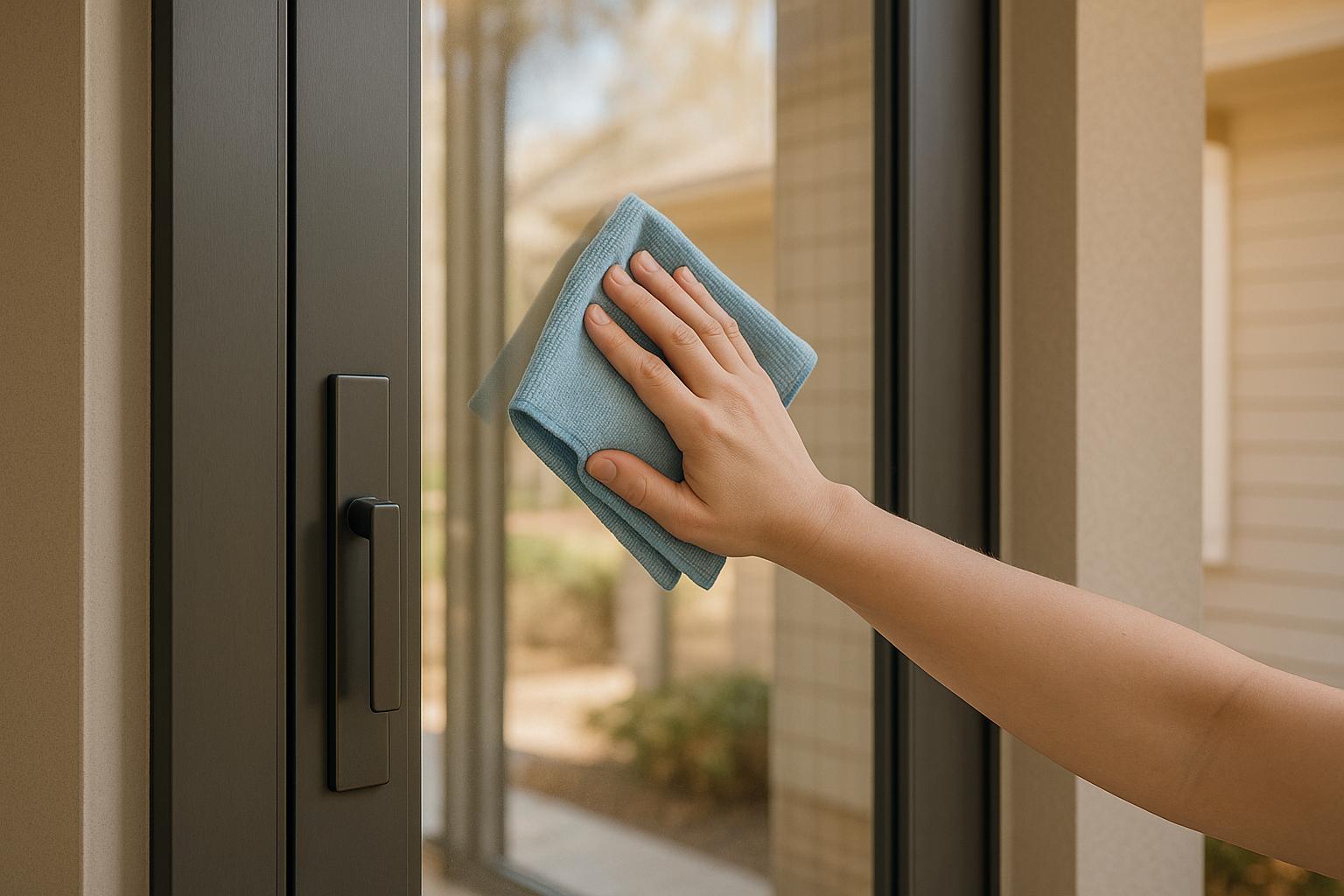Want spotless entry door glass? Keeping your entryway glass clean isn’t just about appearances – it prevents damage, extends the glass’s lifespan, and ensures your home looks inviting. Here’s what you need to know:
- Tools & Supplies: Use microfiber cloths, a squeegee, non-abrasive sponges, and mild cleaning solutions like dish soap or vinegar. Avoid harsh chemicals or abrasive materials.
- Preparation: Check for chips or cracks, protect surrounding areas with drop cloths, and ensure safety by using gloves and stable ladders.
- Cleaning Steps: Start by dusting, apply cleaning solution from top to bottom, tackle tough stains with vinegar or baking soda, rinse thoroughly, and dry immediately to avoid streaks.
- Long-Term Care: Clean regularly, avoid ammonia-based cleaners, and consider protective coatings to reduce future buildup.
Key Tip: Regular maintenance prevents stubborn grime and keeps your glass looking clear year-round. Stick to gentle tools and solutions for the best results.
Tools and Supplies You Need
To achieve streak-free, crystal-clear glass on your entry door, you’ll need the right tools and supplies. Having everything ready before you start will make the process smoother and more efficient.
Cleaning Tools
- Microfiber cloths: These are your go-to for spotless glass. Their soft fibers prevent scratches and eliminate the swirl marks that other materials might leave behind. Use one for cleaning and another for drying to avoid streaks.
- Squeegee: Perfect for removing excess water and cleaning solution without leaving streaks. If your door has tall glass panels, consider a squeegee with an extendable handle to safely reach higher areas. This is a favorite tool among professionals for a flawless finish.
- Non-abrasive sponge or washcloth: Use this to apply cleaning solutions and gently scrub the glass. Make sure it’s labeled non-abrasive to avoid damaging the surface. For stubborn debris, a window scraper can help – just remember to replace the blade regularly.
- Cotton swabs: These are great for tackling those tricky corners where dirt and residue tend to build up. Paying attention to these small details can make a big difference in the overall look of your door.
Cleaning Solutions
For everyday dirt and grime, mix mild dish soap with warm water. This gentle solution works well without harming the glass or any protective coatings. For tougher stains or mineral deposits, distilled white vinegar is a reliable option. It cuts through buildup effectively while being safe for most glass types.
A spray bottle is handy for applying your cleaning solution evenly across the glass surface. If you prefer a store-bought option, choose a cleaner specifically designed for glass to avoid residue or damage to protective coatings.
Additional Supplies
To round out your cleaning kit, keep these extras on hand:
- Rubber gloves: Protect your hands from cleaning solutions and give you a better grip on tools.
- Bucket: Useful for mixing and holding cleaning solutions or rinsing sponges.
- Step stool or ladder: If your entry door has tall glass panels, these will help you safely reach higher areas.
- Silicone-based lubricant: Apply this to the door’s hardware to keep it functioning smoothly.
When cleaning interior glass doors, use minimal water to prevent drips on floors or furniture.
With these tools and supplies ready, you’ll be set for a hassle-free cleaning process that leaves your entry door glass looking like new.
Preparation and Safety Steps
Getting ready before cleaning your entry door glass is essential to avoid damage and ensure the process is safe and efficient.
Check Glass and Frame
Start by examining your door’s glass panels for any signs of damage. Look for cracks, chips, or holes that could worsen during cleaning. Also, inspect the frame, hardware, weather-stripping, and caulk for any looseness or wear. If the frame is wooden, check for water damage or signs of deterioration. Don’t forget to test locks, hinges, and sliding mechanisms to ensure everything is functioning smoothly. This step ensures you’re aware of any potential issues before you begin.
Protect the Area
Lay down drop cloths or towels around the door to shield your floors and nearby surfaces from cleaning solutions and water drips. This simple precaution makes cleanup easier and prevents accidental damage.
Safety Guidelines
Take safety seriously while cleaning. Wear protective gloves and safety glasses to shield your hands and eyes from cleaning chemicals. Avoid using ammonia-based products, as they can pose health risks. If you do opt for an ammonia-based cleaner, make sure the area is well-ventilated by opening windows or doors. Never mix ammonia with chlorine bleach – it creates toxic gases that can be extremely dangerous.
If you need to reach high areas, use a stable step stool or ladder on level ground. For cleaning doors above one story, it’s safer to hire a professional. Lastly, check the weather before starting. Windy conditions can blow debris onto wet glass, making your job harder. A little preparation goes a long way in making the process smooth and safe.
How to Clean Glass Doors
Keeping glass doors spotless doesn’t have to be a chore. Follow these steps to ensure a streak-free shine and a well-maintained door.
Remove Dust and Dirt
Start with a dry cleaning to get rid of loose dirt and debris. Use a microfiber cloth or a soft brush to dust the glass and frame. Don’t forget to vacuum the crevices, especially the corners and edges where dust tends to collect.
If your door features wrought iron designs, grab your vacuum’s crevice tool to clean those intricate curves and patterns. For sticky spots or cobwebs, a dry cloth works wonders. This step ensures that when you move on to wet cleaning, you’re not just smearing dirt around.
Apply Cleaning Solution
Mix up a simple cleaning solution by adding 2–3 drops of mild dish soap to a bucket of warm water. The warm water helps prevent any risk of thermal shock to the glass. Dip a clean sponge or microfiber cloth into the solution, wring it out so it’s just damp, and you’re ready to go.
Start at the top of the glass and work your way down using overlapping horizontal strokes. This method keeps dirty water from dripping onto areas you’ve already cleaned. Apply gentle pressure – let the cleaning solution do the heavy lifting rather than scrubbing too hard, which could damage the glass or push dirt into the frame’s crevices.
For multi-pane doors, clean one pane at a time to ensure consistent coverage and pressure throughout.
Deal with Tough Stains
If regular cleaning doesn’t cut it, tackle stubborn spots like water stains, fingerprints, or tree sap with a stronger solution. Mix equal parts white vinegar and warm water in a spray bottle. Spray it directly onto the stain and let it sit for 2–3 minutes before wiping it away.
For extra-stubborn marks, make a paste with baking soda and a bit of water. Apply it to the stain with a soft cloth and rub gently in circular motions. Baking soda’s mild abrasiveness helps lift tough residue without scratching the glass.
Got paint splatters or sticky adhesive residue? Use a plastic scraper held at a 45-degree angle to gently remove them. Stick to plastic to avoid scratching the surface.
Rinse and Dry
Once the glass is clean, rinse away any soap residue with a damp cloth soaked in plain water. Work from top to bottom to avoid streaks. Then, dry the glass immediately using a squeegee or a lint-free cloth. Don’t let water air-dry, as it can leave behind mineral deposits that are harder to remove later.
Clean Hardware and Frame
Don’t stop at the glass – give the hardware and frame some attention too. Wipe them down with a damp cloth and a little mild soap, then dry them thoroughly. Take extra care with decorative elements where dirt can hide.
For door handles, locks, and hinges, use a slightly damp cloth, then dry completely. A small dab of silicone-based lubricant on moving parts like hinges or locks keeps them working smoothly and prevents squeaks.
If your door has weather stripping, clean these seals with a damp cloth to remove dirt and debris. Avoid harsh chemicals, as they can damage rubber or vinyl seals over time. Finally, wipe down the threshold and surrounding trim to give the entire door a polished, well-maintained look.
sbb-itb-cd90297
Keeping Glass Clean Long-Term
Keeping glass doors spotless isn’t just about occasional deep cleaning – it’s about building habits that prevent grime and protect your investment over time.
Regular Cleaning Schedule
A weekly cleaning routine goes a long way in preventing buildup on your glass doors. After heavy rain or dusty weather, a quick wipe can stop water spots from forming. During seasons like spring and fall, when pollen and leaves are more of an issue, you might need to clean a bit more often to maintain clarity. Setting a phone reminder or jotting it on your calendar can help you stay consistent. Even a quick 5-minute cleaning session can make a big difference. Pairing this routine with the right cleaning products ensures your glass stays clear and pristine for years.
Avoid Harsh Products
To keep your glass looking its best, it’s important to choose your cleaning products carefully:
- Skip abrasive or acidic cleaners. Harsh chemicals can scratch the surface or strip protective coatings, leaving the glass cloudy over time. They can also damage the frame and seals.
- Avoid ammonia-based cleaners. These can cause streaks, degrade seals on multi-pane glass, and even fade tinted surfaces.
- Ditch paper towels and newspapers. These often leave lint, streaks, or even ink residue on the glass. Steel wool or scratchy sponges are also a no-go, as they can permanently damage the surface.
Instead, reach for microfiber cloths and squeegees, which are gentle and effective for a streak-free finish. Another tip? Use distilled water instead of tap water. Tap water often contains minerals that can leave stubborn hard water spots. By sticking to gentle, non-abrasive products, you’ll protect your glass and keep it looking great for the long haul.
Protective Coating Options
Once you’ve nailed down your cleaning routine and product choices, consider adding an extra layer of protection. Applying a hydrophobic coating to your glass doors can make a big difference. These coatings help water bead up and slide off, reducing streaks and spots. For the best results, follow the manufacturer’s instructions for application and curing. If you live in an area with harsh weather or corrosive conditions, consulting a professional might be worth it to ensure your glass stays protected.
Conclusion
Keeping your entry door glass clean and clear is more than just a chore – it’s about creating a welcoming first impression and brightening your home. A well-maintained door not only enhances your home’s curb appeal but also ensures lasting durability and clear visibility.
The secret to achieving this lies in regular upkeep and using the right tools. Whether you clean weekly or monthly – depending on how much traffic and weather your door faces – routine care prevents stubborn buildup that’s harder to tackle later. Equip yourself with essentials like microfiber cloths and squeegees for a streak-free finish. For cleaning solutions, a simple mix of white vinegar and water does wonders, cutting through grime without harming the glass. Finish up with a dry, lint-free cloth to leave the surface gleaming.
Don’t forget the rest of the door! Caring for the frame, hardware, and tracks ensures the entire system looks and works at its best.
For Forever Iron Doors Carolina customers, this routine is especially important. These custom wrought iron doors are handcrafted with precision, and their glass elements deserve the same level of care to preserve their clarity and enhance the beauty of the intricate ironwork. With consistent maintenance, your door will continue to showcase the artistry and craftsmanship that make it one of a kind.
Spending just a few minutes each week on cleaning not only boosts your door’s appearance but also extends its lifespan. Since your entry door is often the first thing visitors notice, make sure it leaves the right impression. A little regular care goes a long way in keeping your entryway elegant and inviting.
FAQs
How can I keep the glass on my entry doors clean and in great condition?
To keep your entry door glass spotless and looking great, mix water with white vinegar or use a glass-safe cleaner. Apply the solution gently with a soft cloth or sponge, then dry it thoroughly using a microfiber cloth or a squeegee to prevent streaks or water spots. For ongoing care, check the seals and frames regularly to ensure they’re in good condition, and steer clear of abrasive cleaners or tools that might scratch the glass. By sticking to gentle cleaning habits and regular upkeep, you can maintain the glass’s clarity and strength for the long haul.
What’s the best way to clean tough stains or mineral deposits from entry door glass without damaging it?
To tackle tough stains or mineral deposits on your entry door glass, start by mixing equal parts of white vinegar and water in a spray bottle. Spray the mixture directly onto the stained area, allow it to sit for a few minutes, and then gently scrub using a soft cloth or sponge. Once clean, rinse thoroughly with water and dry with a microfiber cloth to avoid streaks.
If the stains are particularly stubborn, try making a paste with baking soda and water. Apply the paste using a soft brush, scrub gently, and rinse thoroughly. Be sure to steer clear of harsh abrasives, metal tools, or anything that might scratch or damage the glass.
What precautions should I take when cleaning glass doors with intricate wrought iron designs?
When cleaning glass doors featuring intricate wrought iron designs, always opt for a soft, damp cloth or sponge. This ensures you clean the surface without scratching the glass or harming the delicate ironwork. For those tricky, detailed areas, a small, soft brush works wonders, allowing you to clean gently without causing any damage.
Steer clear of harsh or abrasive cleaners – they can harm both the glass and the iron. Once you’re done cleaning, it’s crucial to dry the wrought iron completely to keep rust at bay. Take care when handling the ironwork to preserve its intricate details and avoid any bending or distortion.



